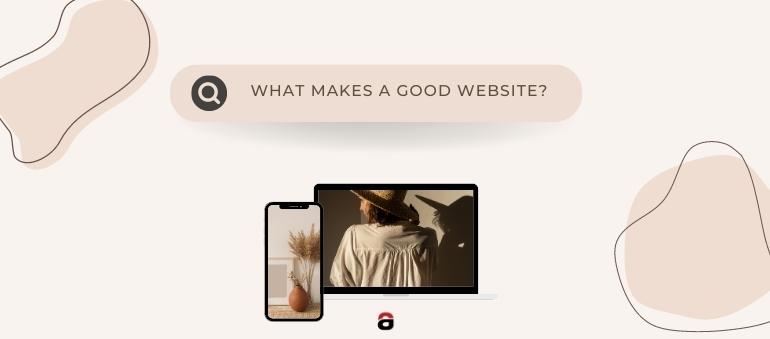In today’s digital age, having a good website is more important than ever. Your website is not only a representation of your brand but also a powerful tool to attract and engage potential customers. According to a recent survey, 94% of consumers said that website design is the primary reason they mistrust or reject a website. On the other hand, a well-designed website can increase customer trust, boost conversions, and drive revenue growth.
A bad website can jeopardize your business, regardless of the quality of the products and services you offer. It can give the impression of unprofessionalism and discourage visitors from becoming customers.
Imagine that you have spent years acquiring knowledge to start a business, gained the trust of clients, and become an authority in a certain industry, but your website does not reflect that quality. The result could be a loss of a large number of clients who are not willing to work with brands that do not meet their basic needs in the digital age.
The good news is that it is possible to create a website that has excellent performance and an attractive design that will attract potential customers and enable your business to grow as it deserves. Therefore, we bring you a guide to follow during the creation or redesign of your website.
What to Pay Attention to When Creating a Website
Let’s take the example of wanting to buy a new car. What will you look at? Color, design, comfort, but also the engine, brakes, gearbox, and overall performance. Only in the combination of design and functionality – you have a winner.
The same goes for a website. An attractive design that will attract and retain users’ attention and flawless functionality that will enable them to do what they came for. Anything below these criteria will not represent you in the best light, nor will it satisfy your potential clients.
But what specifically should a quality website have?
- To meet the intentions and needs of users
- Navigation and functionality – fast and easy to use
- Attractive design
- Quality content
- SEO
- Security
Let’s get into detail about each of these necessary elements.
User Intentions and Needs
The biggest mistake business owners make is creating a website with a focus on the company. No matter how attached you are to your business, which you have invested all your knowledge and experience into, leave that for PR activities. You create a website for customers, not for yourself. Therefore, before any work on it, you should create a content plan that your target audience will identify with and satisfy one of their needs.
Why would your potential customers come to your website? What needs do they need to satisfy? What will bring them to the site and how?
To know what your potential customers are interested in, you must get to know them well. Create profiles of potential customers with demographic data, their desires, problems, needs, marital and financial status, and other.
How do you obtain such data?
Look at social media, forums, reviews, read research on the topics you are dealing with, talk to potential clients. Simply conduct market research.
Only when you know your potential customers well, will you be able to offer them content that is interesting, useful, and provides them with the answers they are looking for.
Navigation and Functionality
Adapting to users does not only apply to content. Navigation, i.e., moving through website pages within the menu, needs to be made simple. This actually means that website visitors can quickly and easily find the information they came for.
How is this achieved?
By respecting the principles of user experience (UX). The pioneer of this approach, scientist Jakob Nielsen, provided clear instructions on how to adapt a website to users. Namely, as he states, visitors need to be offered the website structure they are used to.
“Users spend more time on other sites than on yours. Therefore, when people accumulate experiences from all other pages, it contributes to their understanding of how a website should work. And if your site works like most others, when someone visits it, they will know how to use it,” Nielsen said.
Therefore, stick to the usual website structure that involves a standard page layout in the header and footer.
When it comes to website performance and functionality, the loading speed of the site and each individual page is very important. Several studies have shown that any website opening that lasts longer than three minutes leads to user abandonment. In addition, slow content loading negatively affects the site’s ranking on search engines, as it signals that you are not offering the best user experience to your visitors.
Attractive Design
“Less is more,” said German architect Ludwig Mies van der Rohe in 1947. Attractive design does not mean that you should use all existing animations, videos, and photos you have. This would only overload users, as too many distractions reduce the possibility of action.
Therefore, you will never go wrong if you opt for clarity and simplicity. Do not be afraid of white space, as it contributes to the “readability” of content. Use all visual elements such as animations, photographs, and videos meaningfully.
Another important aspect in website design is whether it is adapted to all devices. Only “responsive” design allows for proper content loading on all screens – mobile phones, tablets, iPad devices, and similar screens with smaller dimensions than computers.
Quality content
Quality content satisfies the user’s information needs, strengthens your authority in the field you operate in, and contributes to better website ranking on search engines.
Each content strategy should include a list of topics for which you will create blog posts. These topics are obtained by researching keywords that match user intentions (search intent). These are usually questions that users search for answers to on search engines.
In addition to blog posts, more detailed forms of content such as guides, case studies, reviews should also be created. These forms should be the result of your research on a particular topic, because only then can you offer original content that competitors do not have.
Therefore, do not create content just to have it. For it to have its purpose, it is very important that it is unique and really answers the questions of the target group. Sometimes it is necessary to engage experts in the field you operate in.
SEO optimization
Search engine optimization (SEO) refers to all activities aimed at better website ranking on search engines. This is very important since research has shown that users do not visit search results beyond the first page on Google.
There are several factors that affect website ranking:
Quality content
Keywords
Backlinks
Internal links
Speed and website architecture
Website security
This is not a final list because Google algorithms are constantly being improved, requiring compliance with new ranking requirements. Therefore, it is very important to follow trends or hire an SEO expert who will do it for you.
Website security
An unsafe website leads to loss of user trust. Google has made it easy for users to recognize website security by marking every safe website with a green confirmation sign in search engine results.
Among other aspects of security, protecting user data is very important for eCommerce websites. This is especially emphasized because customers leave information about their bank cards.
To ensure the security of your website, it is necessary to meet several factors:
- SSL certificate
- Modern theme with secure plug-ins
- Use anti-malware software
- Make a backup of your website
In addition to complying with user protection regulations, the security of the website, as we mentioned, is a signal to search engines to rank it better.
What should you know before making a website?
Before engaging programmers and designers to create a website, you should create a draft of your website to list everything you believe should be on it. This way, you will prevent subsequent changes and prolong the development time.
Your draft should contain the following:
- Website goals
- Profiles of potential customers
- What content should be on the site and through which pages
- What design would best represent your business and how to connect it with your brand
By asking yourself these questions, you will come up with new ideas that you may have overlooked.
So, what makes a good website? It’s a combination of several factors. Remember, your website is often the first and only point of contact that potential customers have with your business. You have only a few seconds to make a good impression and capture their attention. So, make sure you follow these tips and create a website that showcases your brand in the best light possible.
Investing in a good website is a smart business decision that can pay off in the long run. It can help you establish credibility, build brand awareness, and generate leads and sales. By providing a great user experience and valuable content, you can turn your website into a powerful marketing tool that drives business growth. So, take the time to evaluate your website and make the necessary improvements to ensure that it’s performing at its best.



